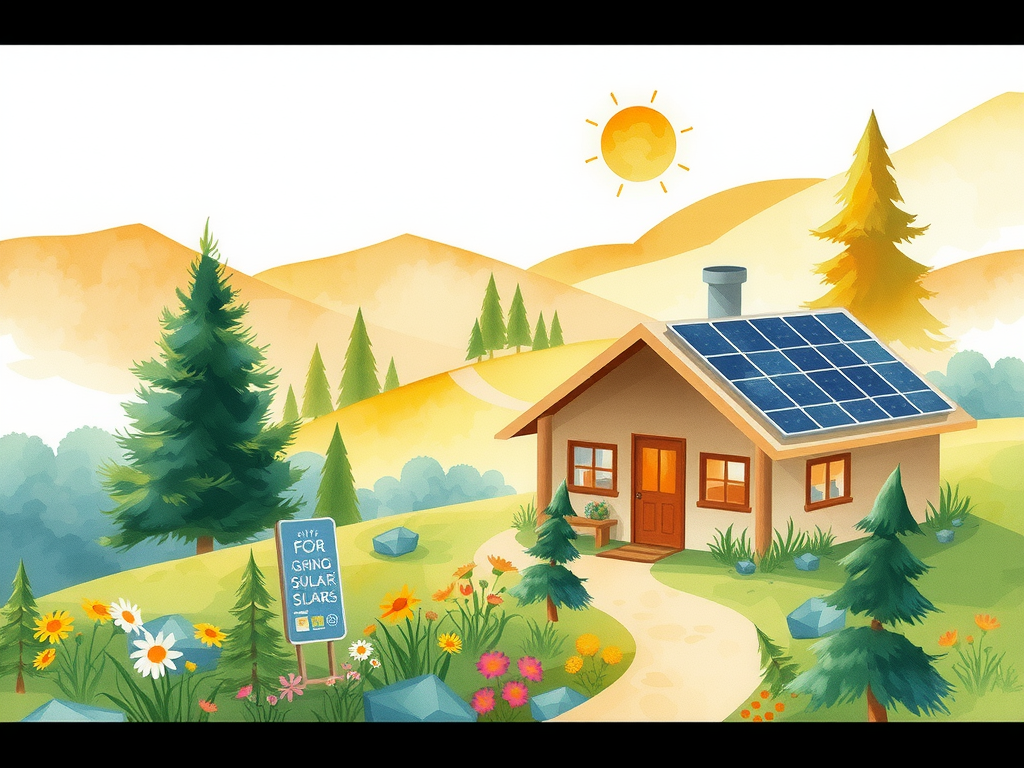
DIY off-grid solar kits allow you to generate your own energy. These kits support energy independence by reducing reliance on utility companies.
With a DIY solar power kit, you can access renewable energy in diverse locations such as remote homes, RVs, and cabins.
Affordable and sustainable, these kits typically include essential components: solar panels, batteries, and inverters.
By investing in a DIY kit, you gain energy self-sufficiency and enjoy significant savings on your electricity bills.
Click here to learn more about: how to make homemade soap at home
Understanding Solar Energy Fundamentals
Solar energy serves as a foundation in the renewable energy landscape. This type of energy harnesses sunlight for power generation using key elements like photovoltaic panels, batteries, and solar inverters.
Familiarity with these components is essential when selecting effective solar solutions. Basic system sizing aids in optimizing your energy consumption.
Knowledge about solar technology and its applications will help you make informed decisions regarding your power management needs.
Components of DIY Off-Grid Solar Kits
DIY off-grid solar kits include all major components necessary for generating, storing, and utilizing energy.
Typical components are solar panels, a charge controller, a battery bank, an inverter, cables, breakers, meters, fuses, and connectors.
Solar panels convert sunlight into DC electricity; the inverter changes DC power to AC for household use. Battery banks store excess energy for nighttime or cloudy conditions.
Charge controllers protect batteries from overcharging.
System Sizing for Energy Needs
Determining the right size for your system involves assessing daily energy use, battery needs, and peak power demand. Common DIY kits range from 5kW to 21kW, tailored for specific energy usage patterns.
Proper sizing ensures that your solar performance meets your energy consumption needs efficiently.
Cost and Savings
The cost for full DIY kits varies widely.
Small systems can start under $1,000, while larger setups may range from $5,000 to $25,
This investment leads to savings on electricity bills and brings energy independence, especially in off-grid or remote settings.
Benefits of DIY Solar Installation
Installing your own off-grid solar system lowers costs and enhances energy self-sufficiency. Many people find it a rewarding project, especially with basic electrical knowledge and safety measures.
Proper design and planning ensure maximum efficiency and safety.
Conclusion
DIY off-grid solar kits provide a practical and affordable solution for energy needs. By understanding the fundamentals of solar energy, you can make informed decisions that lead to a sustainable and independent energy future.

How To Select Photovoltaic Panels
Choosing photovoltaic panels involves knowing solar energy basics. Solar technology can seem complex, but focusing on efficiency helps simplify decisions.
Efficiency ratings are essential; high-efficiency panels convert sunlight more effectively into electricity.
Compare options carefully before purchasing.
A good warranty often signifies quality and reliability. Panels with at least 25 years of warranty are advisable.
Certifications like IEC 61215 or UL 1703 indicate tested quality and performance. Assessing these details ensures you invest in durable and effective solar energy systems that meet your energy needs.
- Check efficiency ratings before purchasing.
- Look for warranties of 25 years or more.
- Look for certifications indicating high performance.
Exploring Diverse Renewable Energy Sources
Diversifying energy sources enhances reliability. Using solar energy in combination with wind or hydro energy ensures continuous power availability. Diversifying your energy sources reduces reliance on one method. Hybrid systems that integrate multiple sources can generate energy during low sunlight and night. This strategy boosts reliability, ensuring a steady power supply even in variable weather conditions.
Benefits of Combining Sources
Combining solar panels with wind turbines increases energy resilience.
This approach optimizes energy production efficiency. A mixed system helps balance energy loads and supports better energy autonomy. Examples include:
- Solar and wind for off-grid living.
- Solar and hydro for constant power generation.
- Solar and battery storage for energy savings.
| Criteria | Importance |
|---|---|
| Efficiency Ratings | High-efficiency panels convert sunlight more effectively into electricity. |
| Warranty Length | Warranties of 25 years or more indicate quality and reliability. |
| Certifications | Certifications like IEC 61215 or UL 1703 ensure tested quality and performance. |
| Hybrid Systems | Combining sources like solar and wind enhances energy resilience and reliability. |
Achieving Self-Sufficiency With Solar Power
Solar energy enables energy independence for many households. Utilizing renewable energy sources can reduce reliance on utility companies.
By harnessing solar energy, users can significantly lower their electricity costs.
Assessing personal energy needs is essential.
Start by tracking energy consumption over a week. Identify the appliances that consume the most power.
This information assists in determining the proper size for your solar system. Energy autonomy through solar installations leads to sustainable living and long-term savings.
DIY off-grid solar kits provide complete systems for producing and using solar power independently.
These kits are suitable for remote homes, cabins, RVs, and mobile setups.
Typical components include solar panels, batteries, inverters, and charge controllers.
Battery banks store excess energy for use at night. Charge controllers prevent battery overcharging and discharging.
The system size should consider daily energy use and peak power demand. Investing in such systems can reduce electricity bills and promote energy self-sufficiency.
Key Factors For Battery Storage Solutions
Battery storage is vital for achieving energy independence in a solar setup.
Proper battery management ensures that surplus solar energy is available during non-sunlight hours.
Lead-acid and lithium-ion batteries are common types used in solar storage.
Start by assessing your daily energy usage patterns to determine the appropriate battery system sizing.
- Calculate total daily energy consumption.
- Account for peak demand hours to avoid shortages.
- Consider using a battery backup to maintain power during cloudy days.
Selecting the right battery type and size enhances solar system performance. DIY solar installation can save costs and promote energy self-sufficiency. Costs for DIY kits typically start under $1,000 and can range to $25,000 for larger systems. Proper system design improves efficiency and battery life, ensuring optimal performance.
Solar Power and Battery Storage
- Homes with solar energy systems can reduce electricity costs by up to 70%.
- Battery storage allows for the use of solar energy at night, enhancing energy independence.
- Proper battery management can extend battery life by 20-30%.
- DIY solar kits can be customized to fit specific energy needs and budgets.
Understanding The Function Of Solar Inverters
Solar inverters are essential components in solar energy systems. They convert direct current (DC) from photovoltaic panels into alternating current (AC), making it usable for home appliances.
Inverter efficiency impacts overall energy usage significantly; for instance, an inverter with 95% efficiency can lead to substantial cost savings each year.
Additionally, battery storage is vital for a solar energy system; it enables energy use during non-sunny hours.
Different inverter types, such as string inverters and microinverters, help in choosing the best fit for your needs.
Types of Solar Inverters
- String Inverters: Commonly used in residential solar installations. They connect multiple solar panels in series.
- Microinverters: Installed on each solar module. They enhance efficiency by optimizing output for each panel.
Impact of Inverter Efficiency
A more efficient inverter can maximize energy production, leading to lower energy bills and increased savings.
For example, a home with a 6kW solar system using a 95% efficient inverter can save approximately $300 annually in electricity costs.
Essential Techniques For Charge Regulation
Charge regulation is essential for maintaining battery health in solar energy systems. It ensures batteries are charged correctly, preventing overcharging and discharging. Common methods include PWM (Pulse Width Modulation) and MPPT (Maximum Power Point Tracking). Selecting the right charge controller depends on your solar system size and energy requirements.
Choosing Charge Controllers
For smaller setups, a PWM controller is often sufficient. In contrast, larger systems benefit from the efficiency of MPPT controllers. Proper charge regulation enhances energy efficiency and prolongs battery life.
Practical Tip for Charge Regulation
Consider your daily energy use when sizing your battery storage and choosing your charge controllers.
This ensures optimal performance and longevity of your battery bank while maximizing solar power usage.
Solar Inverters and Charge Regulation
- Solar inverters convert DC electricity from photovoltaic panels into AC electricity for home use.
- An inverter with 95% efficiency can save homeowners approximately $300 annually in electricity costs.
- PWM and MPPT are common methods for charge regulation, impacting battery health and efficiency.
- Proper sizing of battery storage and charge controllers is crucial for maximizing solar power usage and battery longevity.
Enhancing Energy Efficiency In Off-Grid Living
Energy efficiency is key for off-grid living. Solar energy provides a renewable power source.
This minimizes reliance on traditional energy sources.
Integrating solar power into your daily life can lead to significant benefits.
Understanding the components of a solar energy system is essential. Energy-efficient appliances can greatly reduce energy consumption while maximizing solar benefits.
Integrating Solar Power with Lifestyle Choices
A DIY off-grid solar kit can be a complete solution for generating and using solar energy.
These kits are not connected to the utility grid and rely fully on self-generated solar power. Typical components include:
- Solar panels for converting sunlight into electricity
- Inverters to change DC into usable AC power
- Battery banks to store excess energy for later use
- Charge controllers to protect batteries from overcharging
System sizing is based on daily energy usage and peak power demand. Kits can range from 5kW to 21kW, customizable for specific needs. A typical cost for DIY kits varies, with small systems under $1,000 and larger setups starting around $5,
DIY installation reduces overall costs, promoting energy self-sufficiency.
Energy Conservation Techniques
Implementing energy conservation techniques can enhance efficiency. Simple actions include:
- Using LED lighting for lower energy consumption
- Adjusting your energy use during peak solar production times
Regular maintenance of solar components is vital for optimal solar performance. This ensures your setup remains effective and efficient.
Investing in off-grid solar systems supports a sustainable lifestyle. These solutions are ideal for remote areas, cabins, and RVs. Utilizing solar technology can significantly reduce electricity bills and reliance on traditional grids.
| Component | Function |
|---|---|
| Solar Panels | Convert sunlight into electricity |
| Inverters | Change DC power into usable AC power |
| Battery Banks | Store excess energy for later use |
| Charge Controllers | Protect batteries from overcharging |




